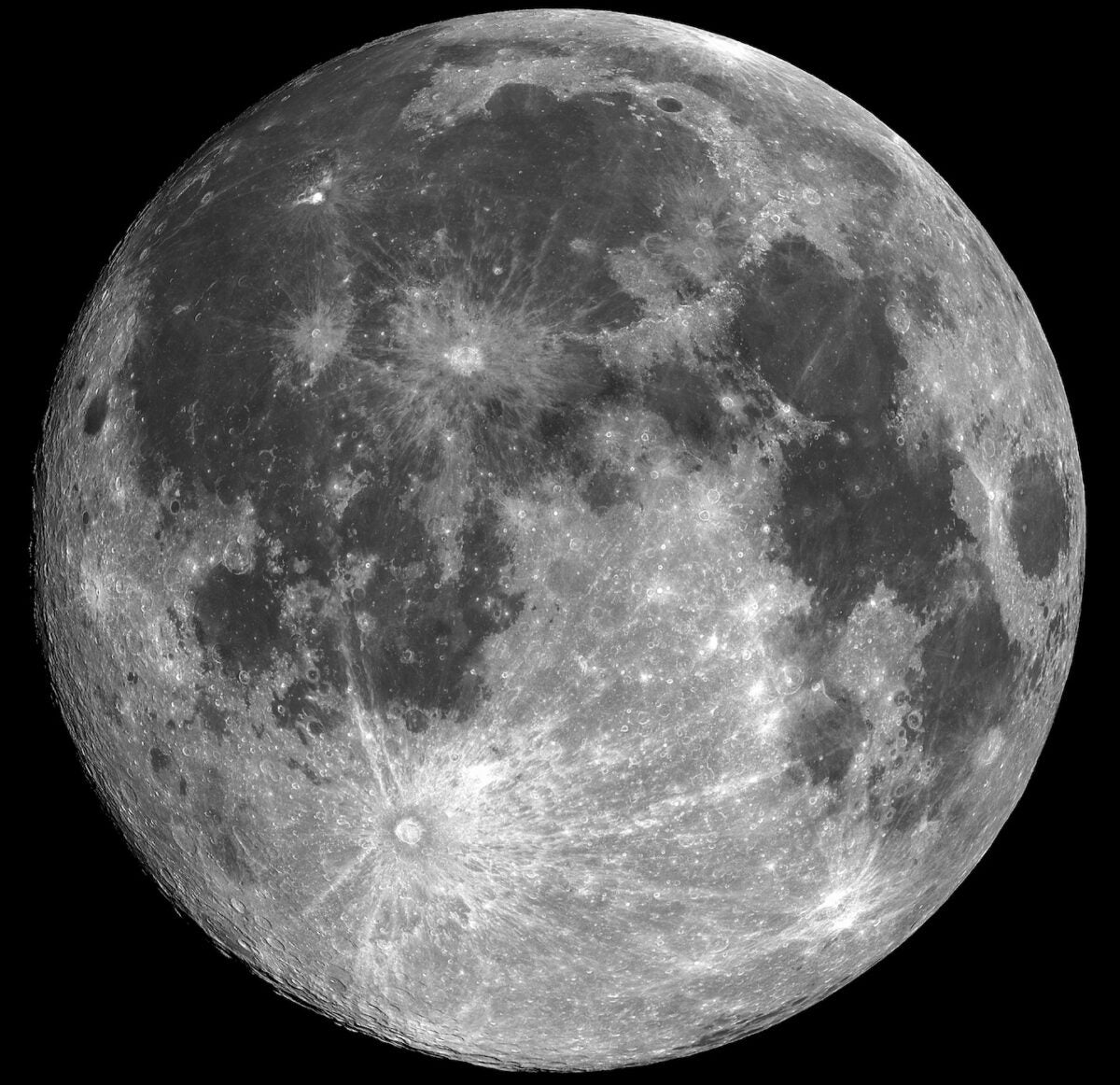
All photos by Robert Reeves
For over 400 years, legions of lunar cartographers have been surveying the surface of the Moon — first by telescope and then by spacecraft — charting and naming its features.
The resulting lunar map is constantly evolving. Over time, new names are added while existing names are dropped or changed after research shows a feature to be of a different geological type. The International Astronomical Union (IAU) establishes guidelines for lunar names; their approval is required to make a name official. These efforts keep scientific order in how we identify features and navigate the face of the Moon.
But our relationship with the Moon is not all science and regulated order. It is human nature to create endearments for the things we love. Deep-sky observers bestow unofficial nicknames to many, like the Lagoon (M8), Rosette (NGC 2237–9/44), and California (NGC 1499) nebulae. Luna is no exception; it too has its share of fanciful unofficial names for its features.
Human whimsy often trumps science in these names, such as the Cobra Head at the volcanic source that once fed flowing lava into Schröter’s Valley. During the Apollo expeditions, many astronauts made their mark on the Moon by giving features unofficial names, such as Jim Lovell’s famous Mount Marilyn, which he named after his wife during Apollo 8. While some of these popular lunar names are eventually rubber-stamped by the IAU (including Mount Marilyn in 2017), others do not appear on a map, but persist by general acceptance.
The selection of unofficial names presented here include some modestly proposed by the author. Whether they stick in lunar lexicon depends on the whims of Moon lovers everywhere.
Lunar nicknames bring life and familiarity to a stark and unforgiving landscape that is nonetheless appealing because of its alien strangeness. For the avid astronomer, the names here should become as familiar as the terms of endearment that we apply to the gems of the Milky Way and beyond.
1. The Steppingstones
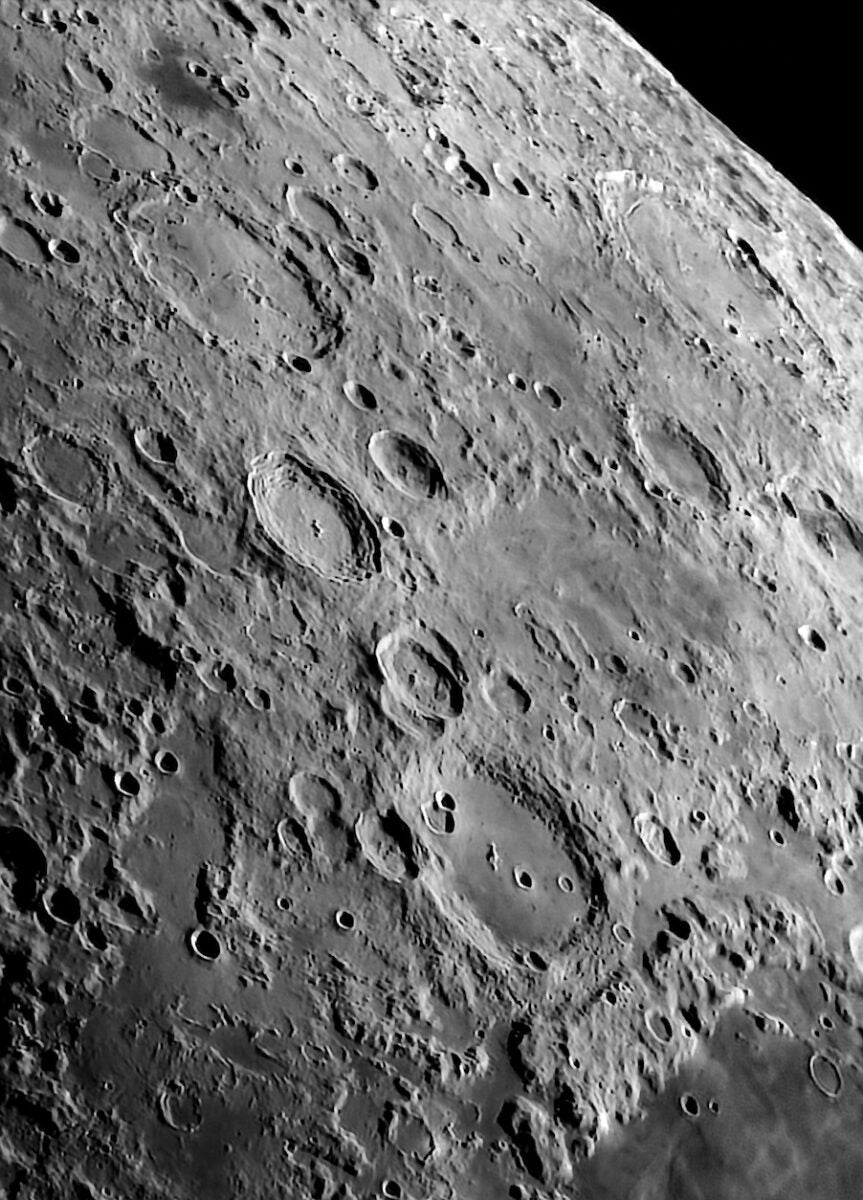
Named by: Robert Reeves
Official name: Cleomedes, Burckhardt, Geminus, and Messala craters
Size: 81 miles (131 km), 34 miles (54 km), 51 miles (82 km), 76 miles (122 km)
Coordinates: centered at 33.5° N, 57.8° E
Feature named after: Appearance of sequential steppingstones
The linear string of four large craters extending north from Mare Crisium (at far lower right in this image) is reminiscent of steppingstones leading off to an adventuresome place. Each step is a leap through time, as none of these craters are the same age. The southernmost is flat-floored Cleomedes, an 81-mile-wide (131 kilometers) Nectarian-epoch crater that dates back 3.85 billion to 3.95 billion years ago. The smaller and slightly younger Imbrian-epoch crater Burckhardt follows. Farther north the sharper form of Geminus is even younger, dating to the Eratosthenian epoch. The final steppingstone, massive, ruined, pre-Nectarian-epoch Messala, is the oldest.
2. The Headlights
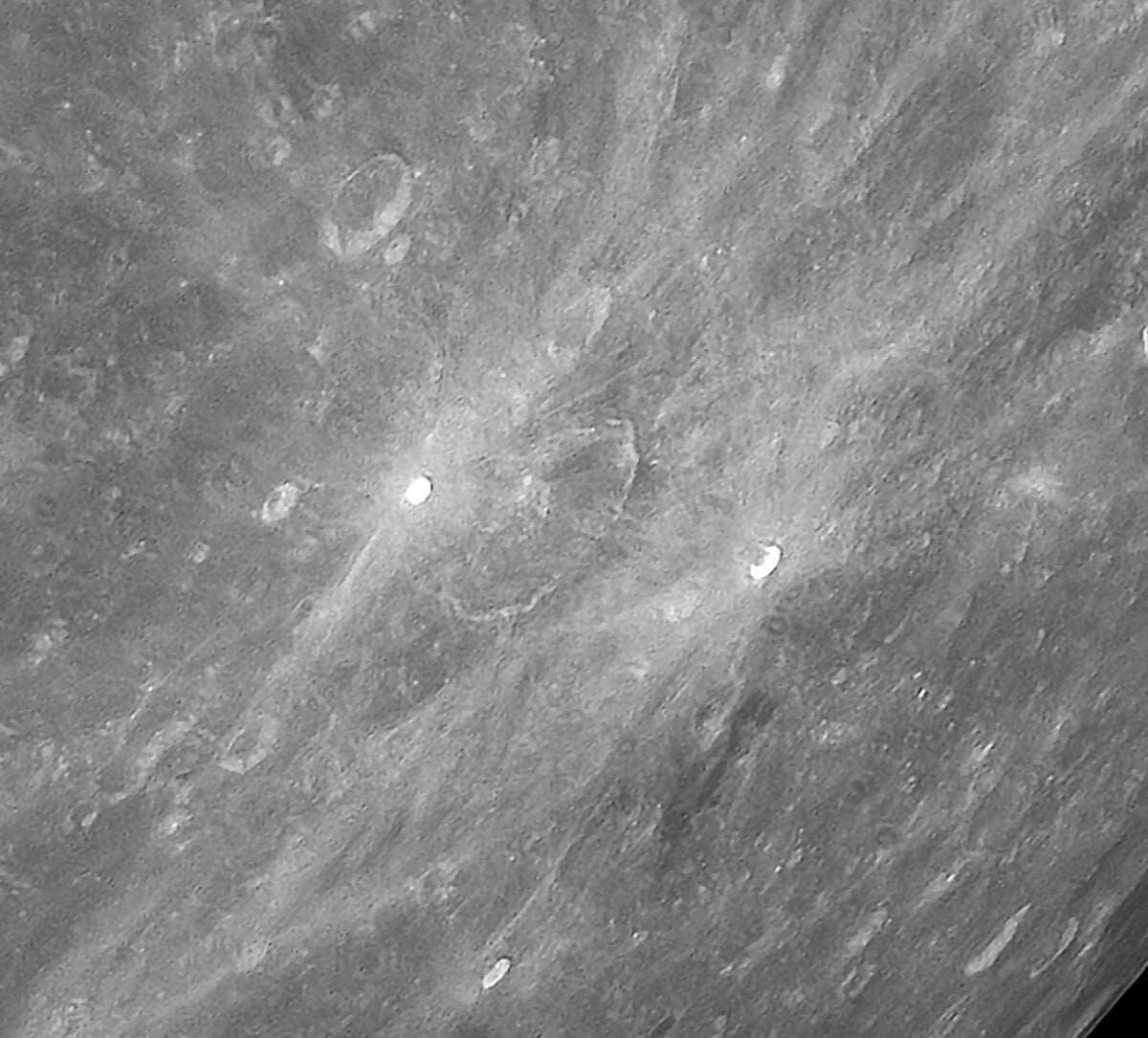
Named by: Unknown
Official name: Furnerius A, Stevinus A
Size: 7 miles (11 km), 5 miles (8 km)
Coordinates: 33.0° S, 54.7° E
Feature named after: Appearance of oncoming car headlights
Satellite craters usually do not draw the casual observer’s attention, but the brilliant, similar-sized Furnerius A and Stevinus A are an exception. Both young Copernican-epoch craters display disproportionately bright ray systems. The brilliant craters bracket the 45-mile-wide (72 km) Stevinus on the Moon’s southeast quadrant, creating the illusion of approaching car headlights.
3. The Lunar Good-Luck Charm
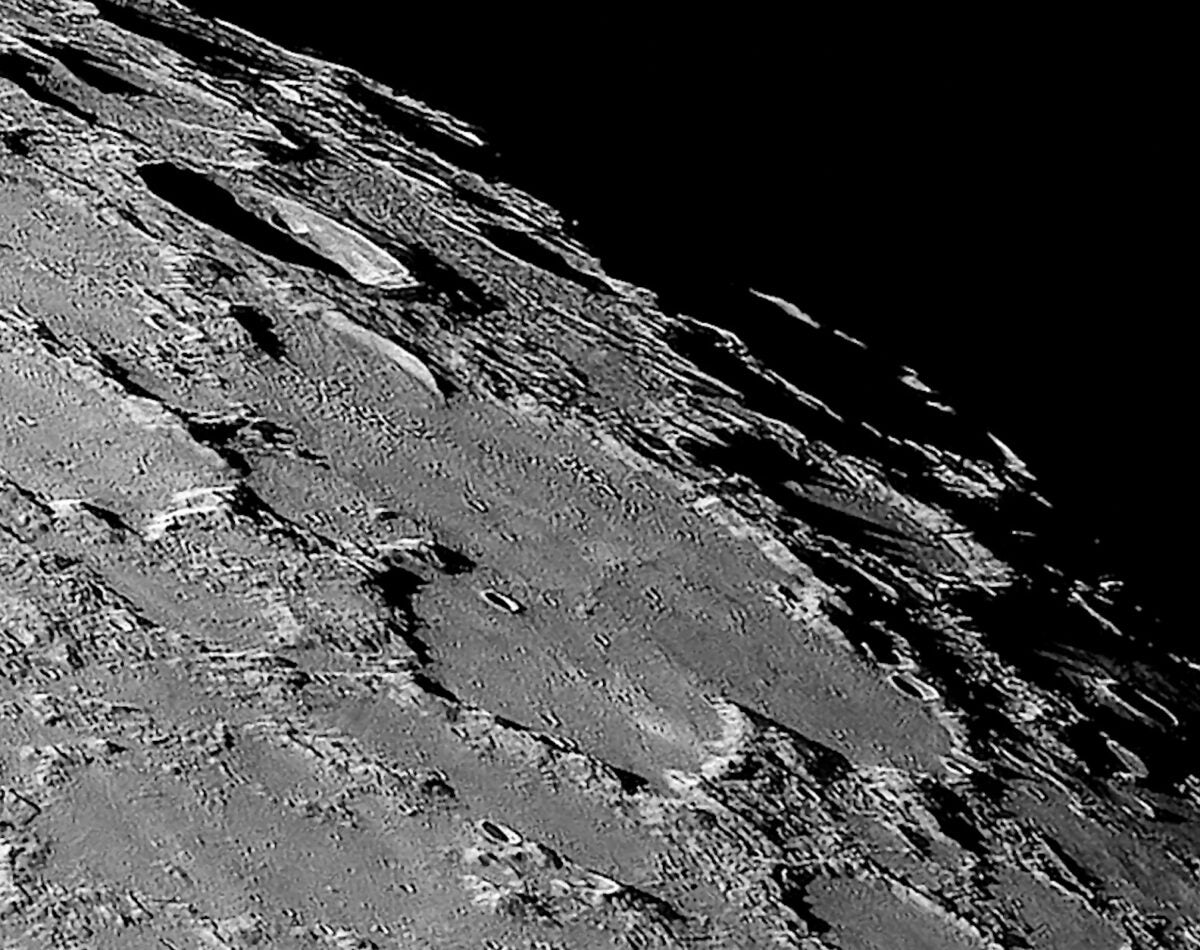
Named by: Robert Reeves
Official name: Meton, Meton C, D, E
Size: 124 miles (200 km)
Coordinates: 72.6° N, 20.0° E
Feature named after: Appearance of a four-leaf clover
The merged forms of craters Meton C, D, and E overlaying Meton Crater on the northern polar landscape create a four-leaf clover shape representing a lunar good-luck charm. The interiors and rims of all four pre-Nectarian-epoch craters were buried by the wave of ejecta thrown from the Imbrium Basin impact 3.85 billion years ago, forming a common floor lying 5,000 feet (1,500 meters) below the surrounding territory.
4. The Liebig Wall
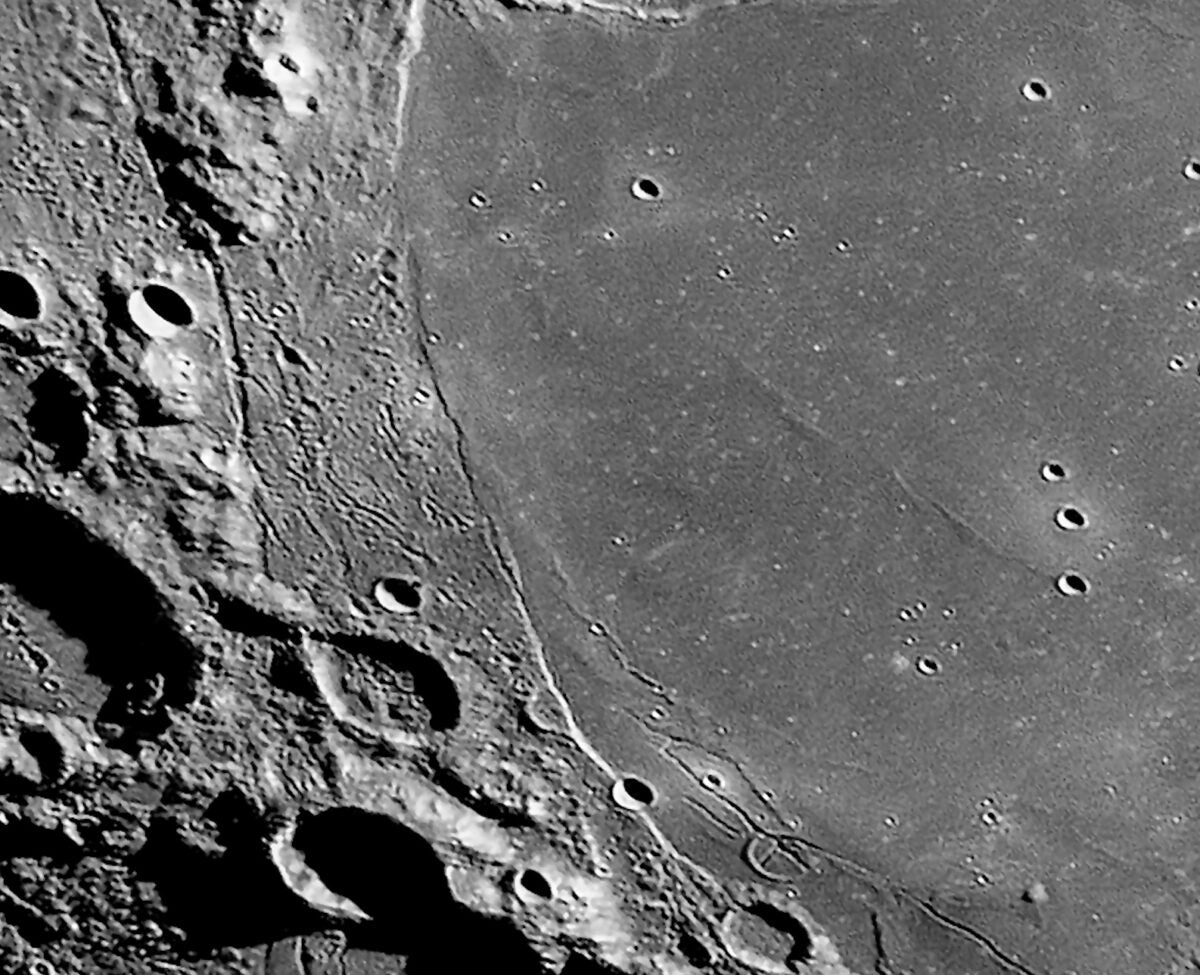
Named by: Unknown
Official name: Rupes Liebig
Size: 90 miles (145 km)
Coordinates: 45.9° W, 25.1° S
Feature named after: Scarp with the same name
Lengthy Rupes Liebig arcs along the western shore of Mare Humorum and descends 2,300 feet (700 m) to the mare floor. The 6-mile-wide (9 km), 5,600-foot-deep (1,700 m) crater Liebig F lies atop the scarp and inspires the unofficial designation of the Liebig Wall.
5. Hill’s Waterfall
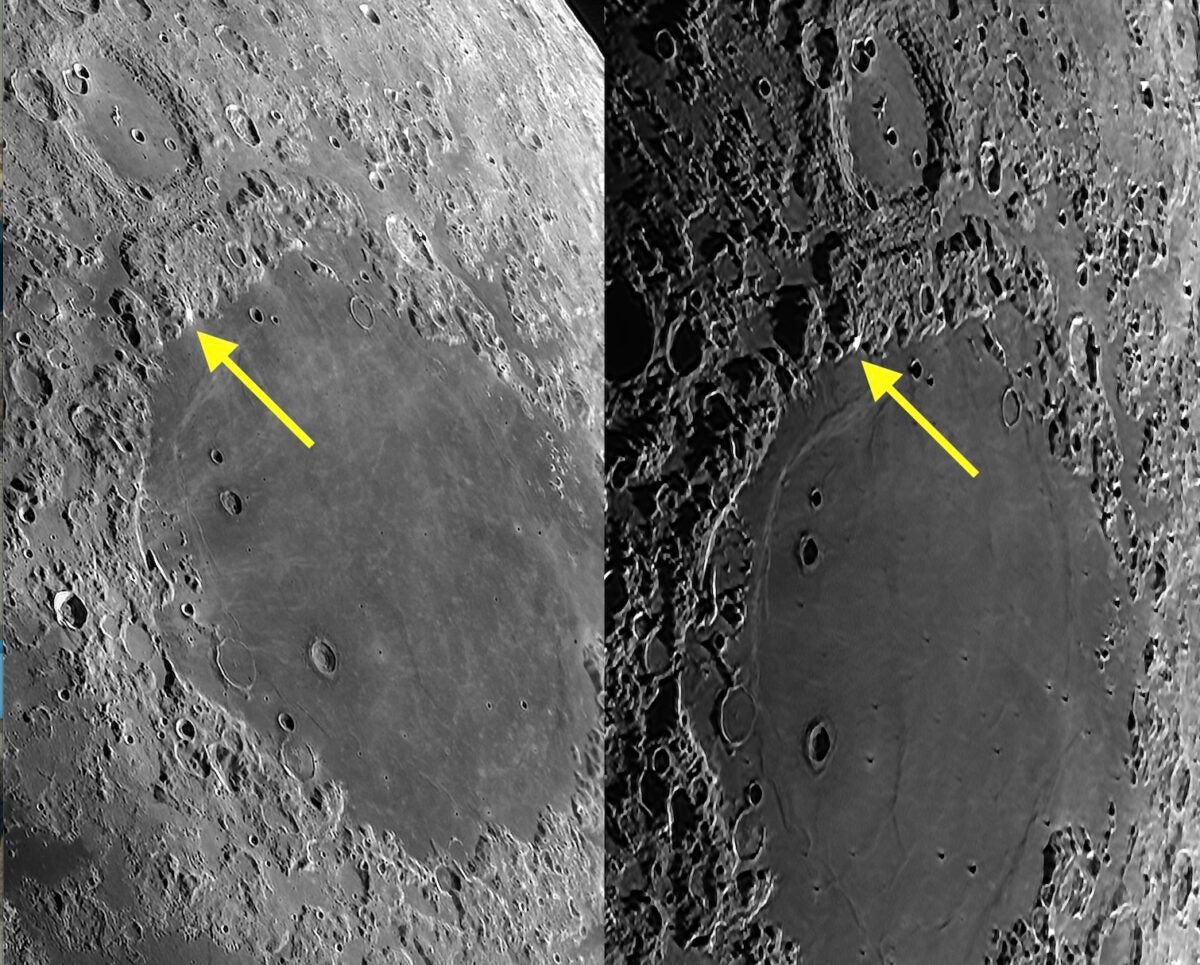
Named by: Robert Reeves
Official name: None
Size: 6 miles (10 km)
Coordinates: 22.0° N, 55.5° E
Feature named after: Resembles a waterfall cascading down a mountainside
A bright splash of light-colored material ejected from a 0.8-mile-wide (1.3 km) craterlet on a mountainside on the northern rim of Mare Crisium looks almost as if it were a waterfall cascading down to the plain below. This bright, white spot can be found by following the northward arc of the craters Picard, Pierce, and Swift on the western side of Crisium. The spot has been reported to be a transient lunar event, as its reflectivity is variable and dependent on the Sun illumination angle, as seen in a comparison of these two images. The physical feature, however, is permanent. While the spot has no official name, Rik Hill, now retired from the University of Arizona, published an analysis of it — thus, it is referred to as Hill’s Waterfall.
6. The Spider
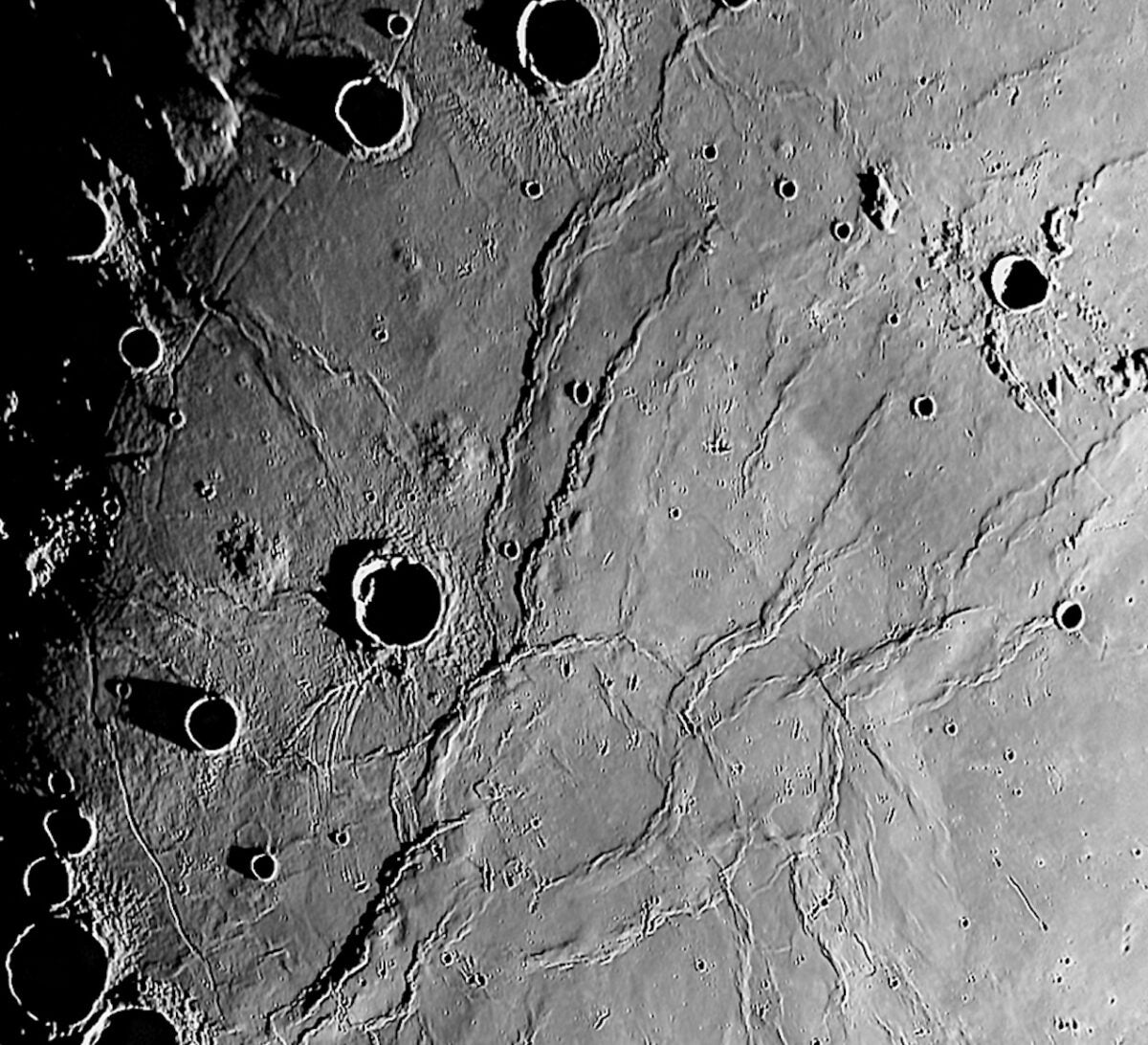
Named by: Robert Reeves
Official name: Lamont
Size: 52 miles (83 km)
Coordinates: 5.1° N, 23.3° E
Feature named after: Spiderlike appearance
First charted as a ghost crater on western Mare Tranquillitatis, Lamont is now regarded as a small ghost basin due to the 84-mile-wide (135 km) outer ring surrounding it. Lamont contains a spiderlike structure consisting of a system of lengthy radial wrinkle ridges that rise between 330 and 1,000 feet (100 and 300 m) above their surroundings. These form the legs of the spider.
7. The Lunar S
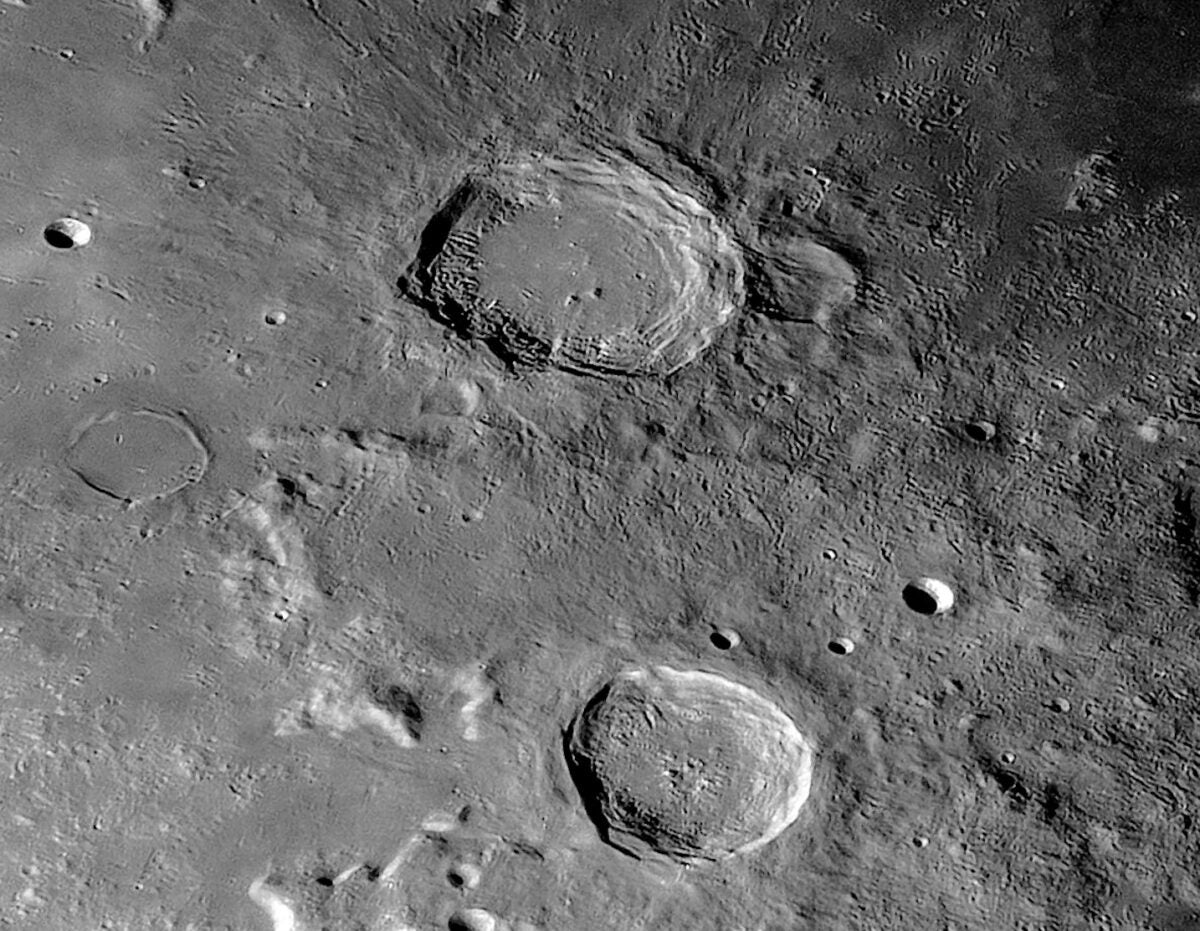
Named by: Robert Reeves
Size: 44 miles (70 km)
Coordinates: 50.2° N, 20.1° E
Feature named after: Appearance of the letter S under sunset illumination
The apparition of the letter S appears for several hours at sundown on the eastern flank of Aristoteles Crater. The S is a combination of the northern rim of 19-mile-wide (30 km) Mitchell Crater, protruding from under Aristoteles’ eastern rim, and the swirl of topography north of Mitchell.
8. Valentine Dome
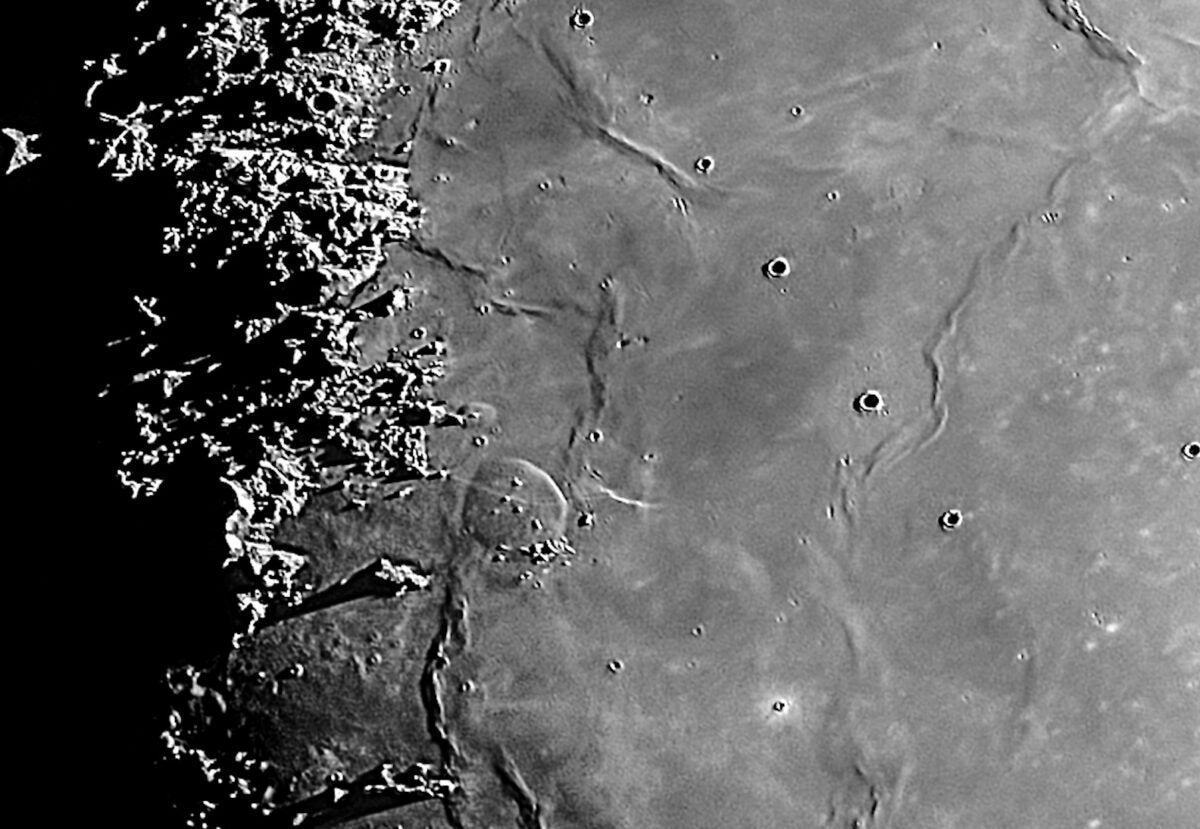
Named by: Unknown
Official name: Linné A 1
Size: 22 miles (35 km)
Coordinates: 30.4° N, 10.1° E
Feature named after: Appearance of a Valentine’s heart
The volcanic dome Linné A 1, just right of center in this image, rises 1,000 feet (300 m) above western Mare Serenitatis and is topped by half a dozen smaller volcanic domes, some capped with a small caldera. The rounded pancake-shaped dome resembles a classic Valentine’s heart.
9. Heart of the Moon
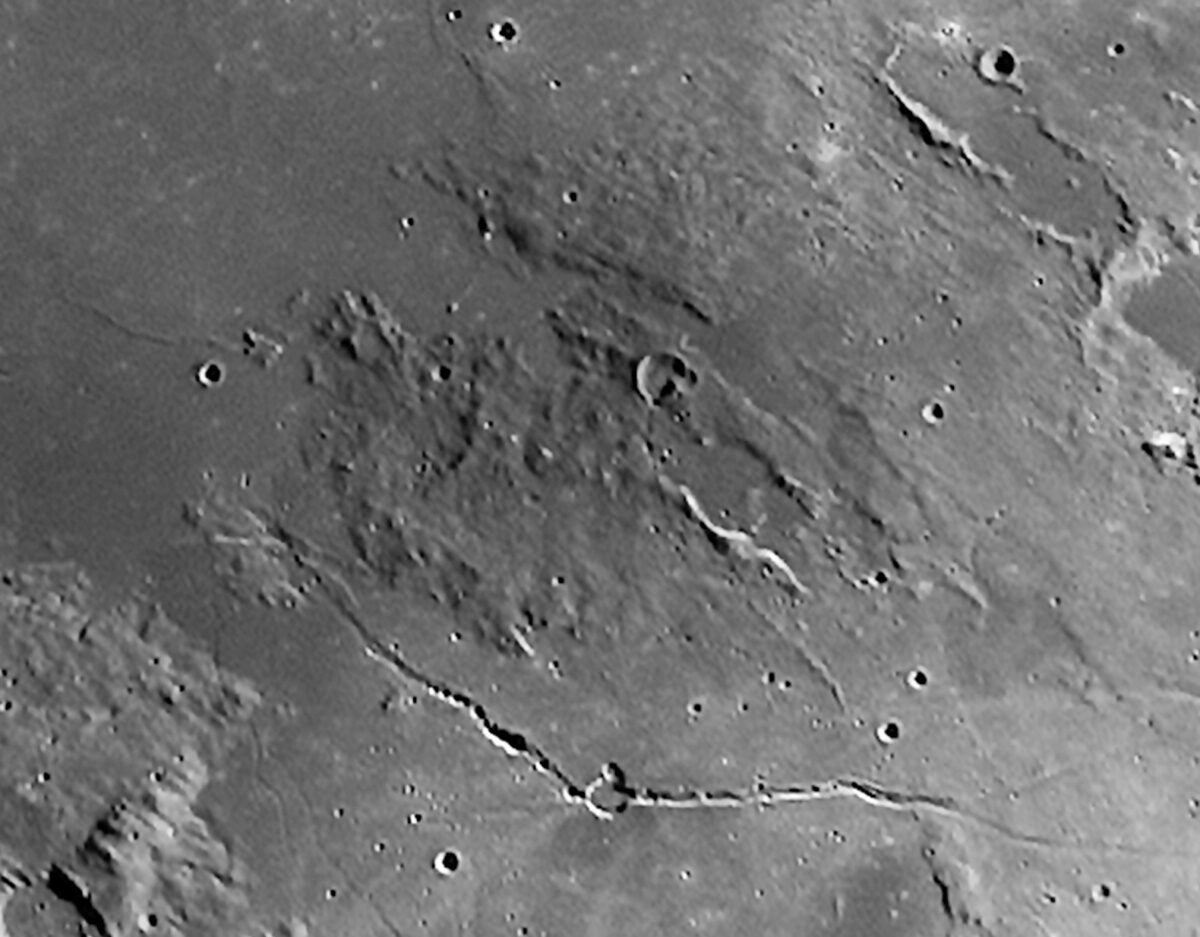
Named by: Robert Reeves
Official name: None
Size: 93 miles (150 km)
Coordinates: 10.5° N, 6.8° E
Feature named after: Heart-shaped appearance
Some 370 miles (600 km) south of Valentine Dome lies another heart-shaped feature: the dark volcanic-ash-dusted mountains north of Rima Hyginus on Mare Vaporum, which reach 3,300 feet (1,000 m) in elevation. The mountains have no official name, but the overall appearance of the rugged region prompts the unofficial designation of the Heart of the Moon.
10. The Lunar X
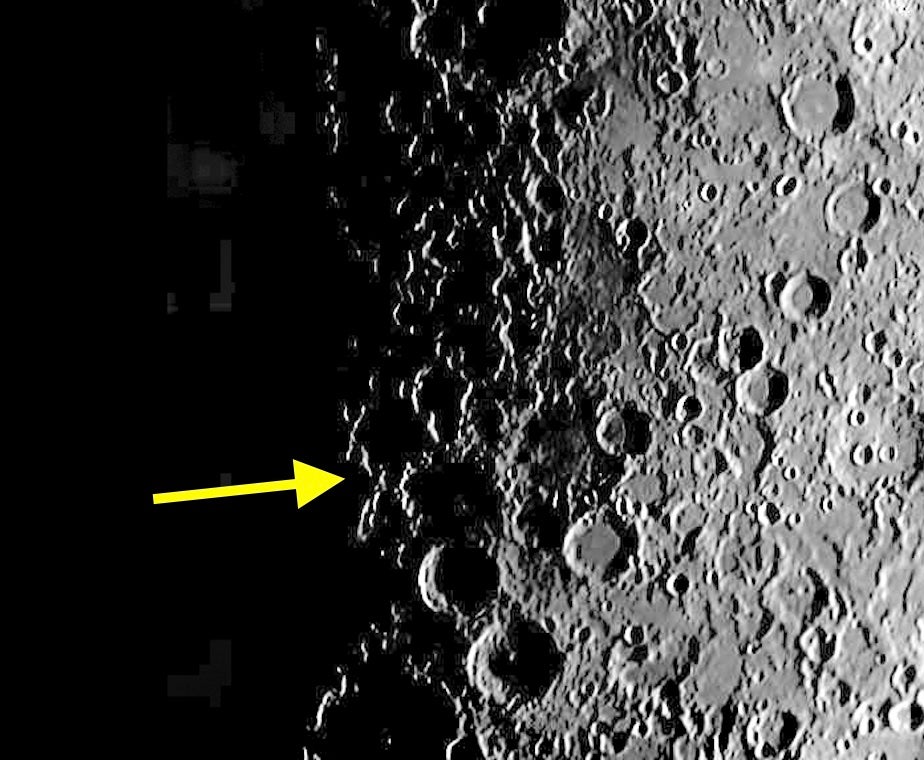
Named by: Unknown
Official name: None
Size: 68 miles (110 km)
Coordinates: 25.4° S, 1.0° E
Feature named after: Appearance of the letter X
As the First Quarter sunrise terminator crosses the merged rims of the adjacent craters Purbach, La Caille, and Blanchinus, they protrude in an X-shaped pattern that catches the first rays of sunrise and remains visible for about four hours.
11. The Marius Hills and Tadpole
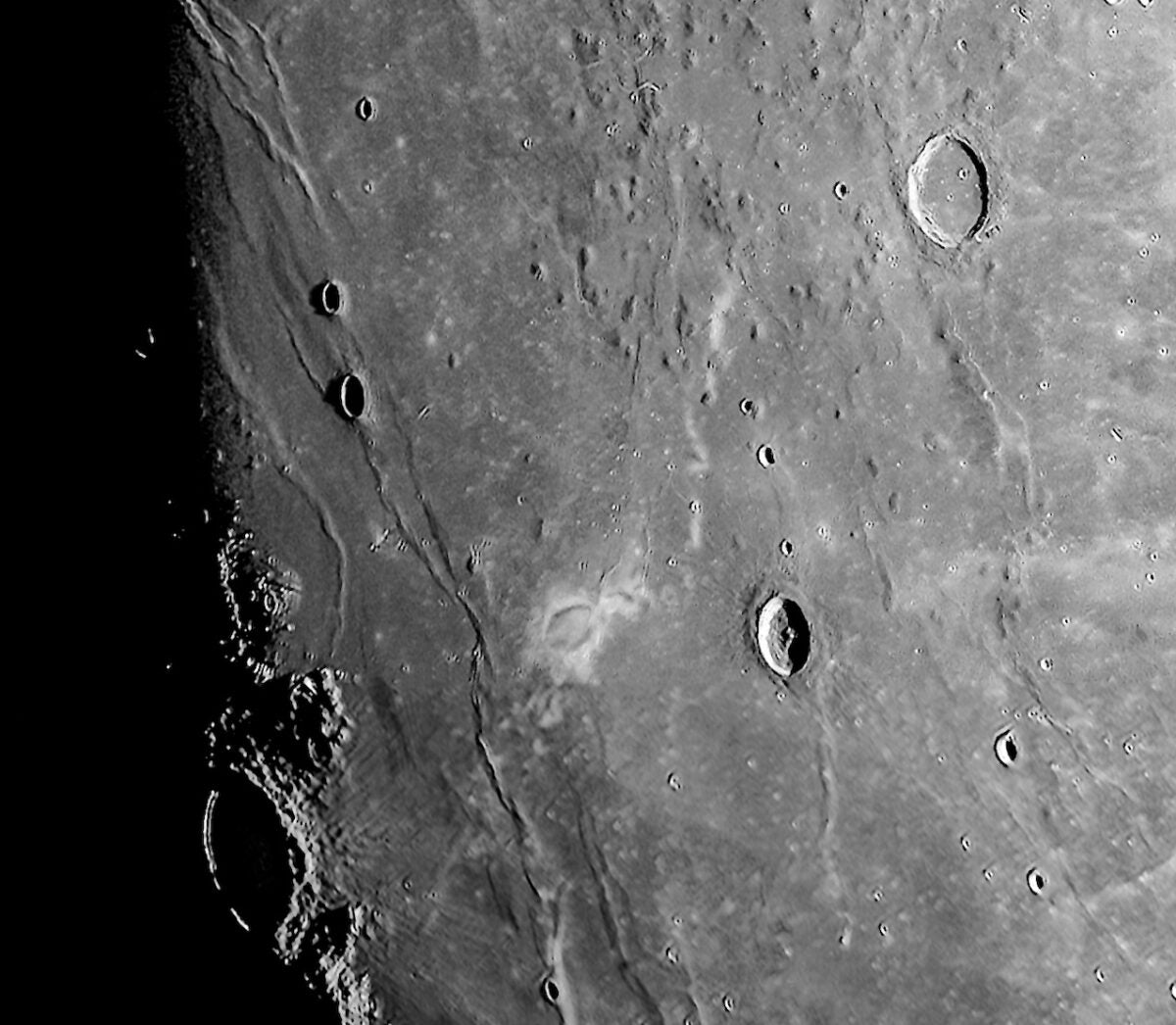
Named by: Unknown
Official name: Hills: none; Tadpole: Reiner Gamma
Size: Hills: 171 miles (275 km); Tadpole: 124 miles (200 km)
Coordinates: Hills: 12.6° N, 53.9° W; Tadpole: 7.6° N, 58.6° W
Feature named after: Hills: nearby crater Marius; Tadpole: resemblance to a frog tadpole
The Marius Hills are the unofficial name for the 262 individual mounds on a 27,000-square-mile (70,000 square km) region of Oceanus Procellarum west of the crater Marius. Although casually called hills, the features are volcanic domes and cinder cones. Reiner Gamma, located west of the Marius Hills and affectionately known as the Tadpole, gets its nickname from its resemblance to this stage in a frog’s life cycle. This feature possesses no vertical relief, does not cast a shadow, and is officially classified as an albedo feature.
12. Straight Wall and Ancient Thebit
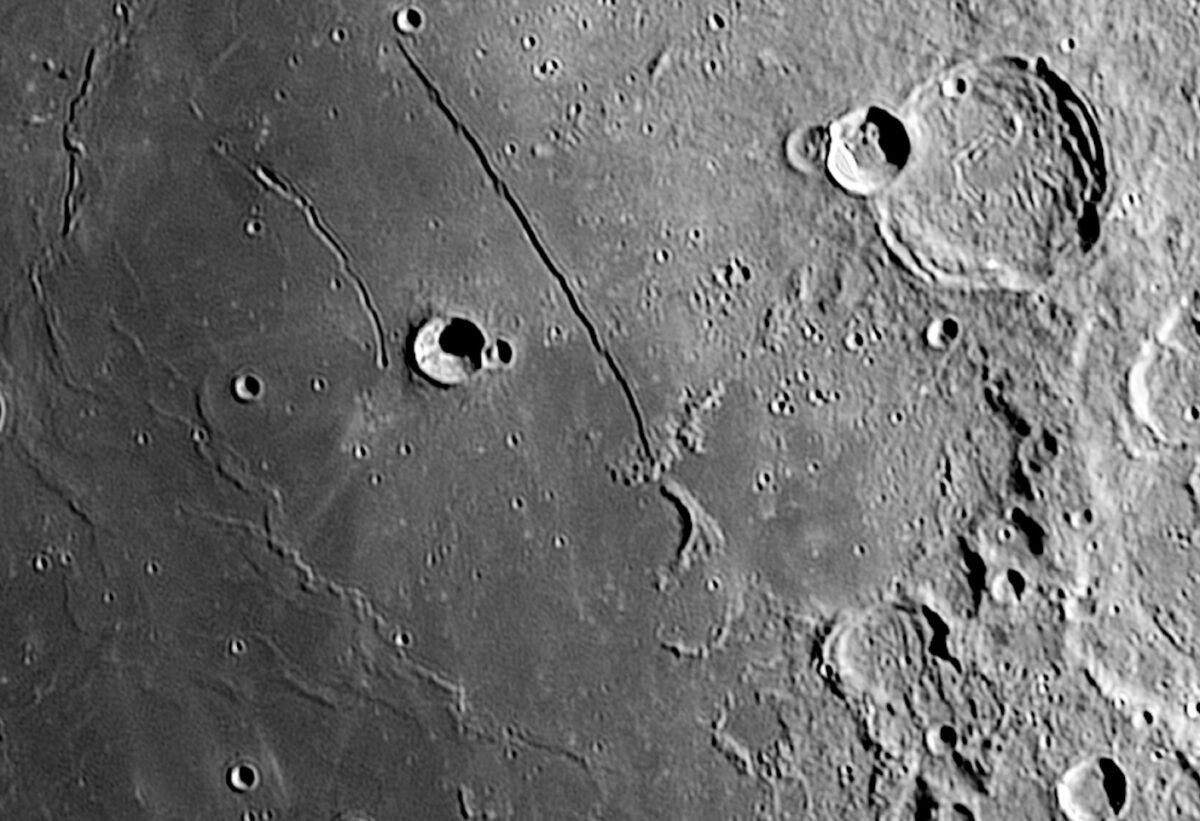
Named by: Straight Wall: Birt and Lee (1865); Ancient Thebit: Chuck Wood
Official name: Straight Wall: Rupes Recta; Ancient Thebit: none
Size: Straight Wall: 72 miles (116 km); Ancient Thebit: 105 miles (170 km)
Coordinates: 21.7° S, 7.7° W
Feature named after: Straight Wall: Linear appearance; Ancient Thebit: Proximity to Thebit Crater
Rupes Recta is a lengthy linear feature known by the beloved name of Straight Wall (a rough translation of its Latin name). It is also known as Huygens’ Sword in honor of 17th-century astronomer Christiaan Huygens, who studied the feature. The curved exposed crater rim at the southern end of Rupes Recta is also known as the Stag’s Horn. Straight Wall lies in an unnamed ghost crater marked by a horseshoe-shaped bay east of the Wall and the circular wrinkle ridges west of it. This crater was unofficially designated Ancient Thebit by Chuck Wood after the nearby, younger Thebit Crater.
13. The Guardians
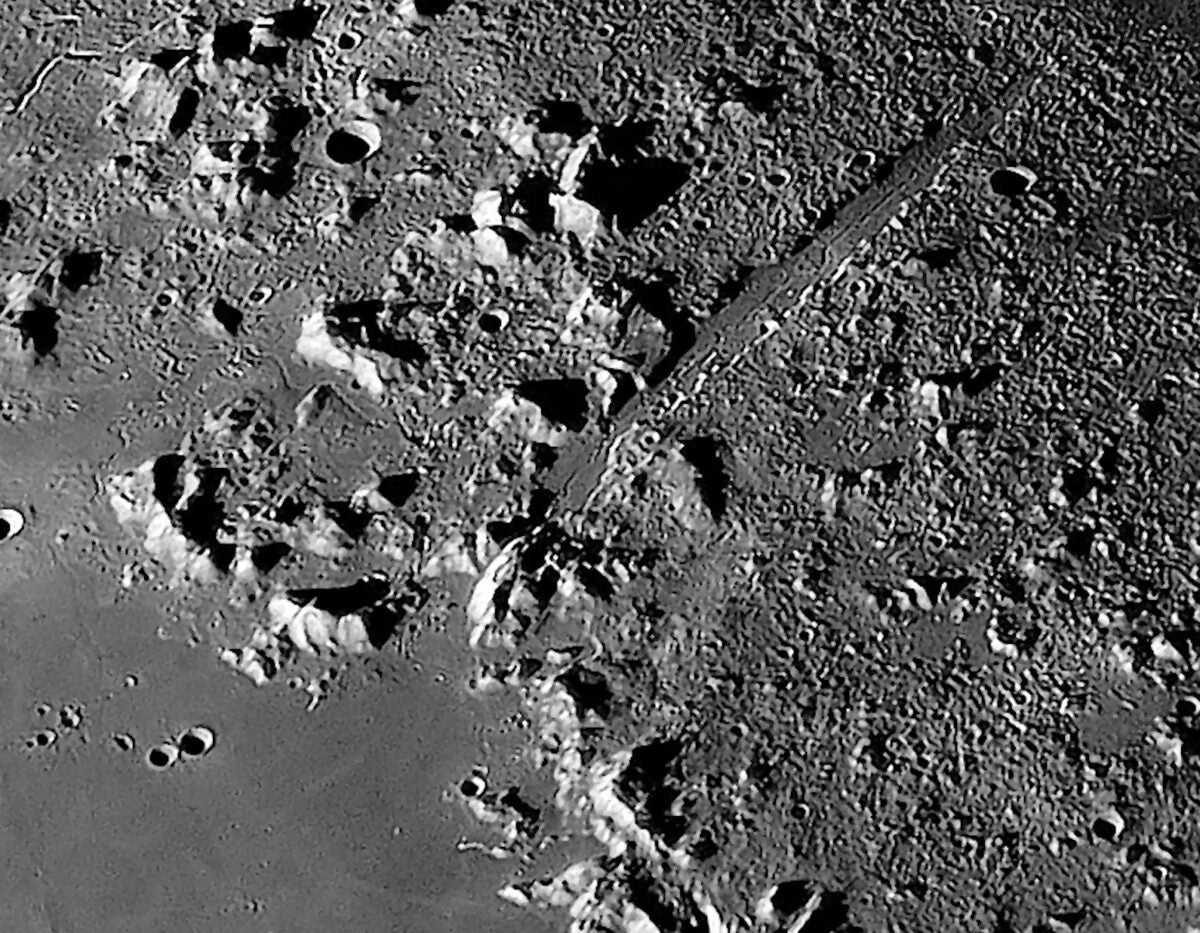
Named by: Chuck Wood
Official name: None
Size: 13 miles (21 km)
Coordinates: 47.8° N, 0.3° W
Feature named after: Two mountains “guarding” a narrow gorge
The mouth at the western end of the Alpine Valley (Vallis Alpes) slashing through the lunar Alps (Montes Alpes) funnels from 13 miles (21 km) across down to a gorge just 660 feet (200 m) wide at the valley’s entrance. The narrow channel is bounded by a northern massif that rises 6,500 feet (2,000 m), while the southern massif rises 8,200 feet (2,500 m) above the plains of Mare Imbrium. Chuck Wood unofficially named the twin mountains the Guardians.
14. The Railroad Tracks
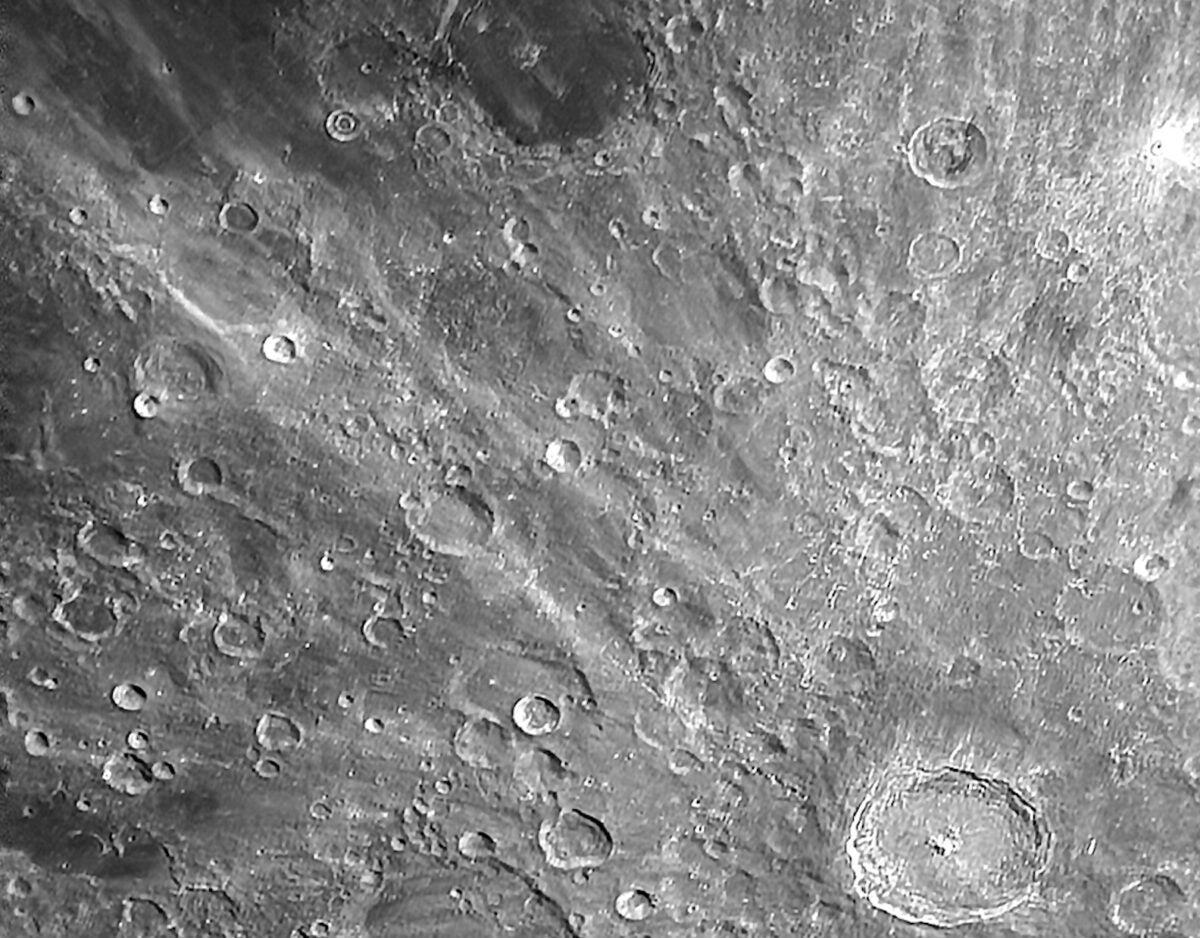
Named by: Unknown
Official name: Tycho rays
Size: 447 miles (720 km)
Coordinates: 32.8° S, 19.5° W
Feature named after: Parallel placement, akin to railroad tracks
Tycho Crater’s two prominent northwestern ray streamers do not diverge from a point within Tycho, and each ray is tangential to the crater’s rim. This unusual parallel nature prompted the unofficial designation of the Railroad Tracks.
15. Ghosts of Procellarum
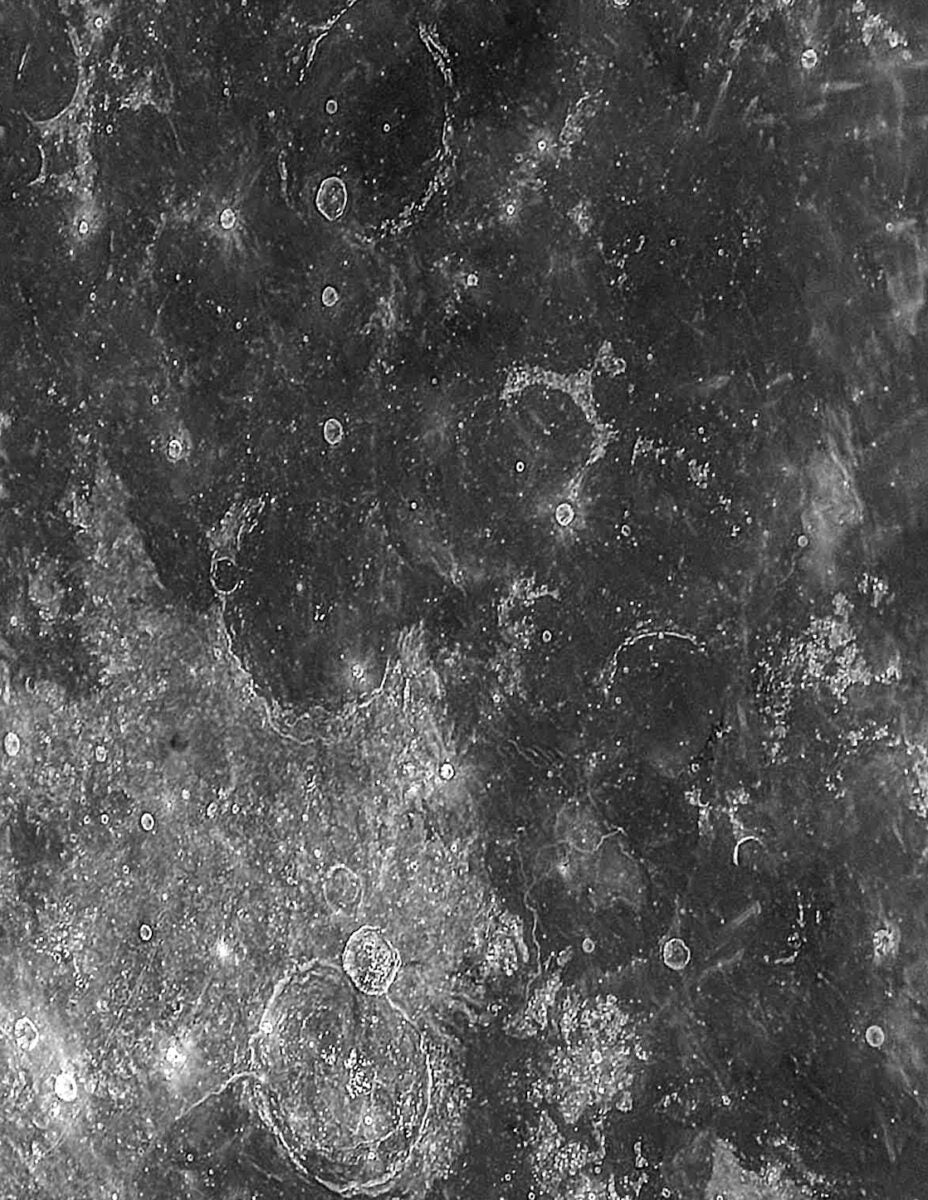
Named by: Robert Reeves
Official name: Flamsteed P, Wichmann R
Size: 62 miles (100 km), 40 miles (64 km)
Coordinates: 4.5° S, 40.7° W
Feature named after: Ghost crater locations
The Moon’s large basins were once dotted with craters, before volcanic flooding flooded many of them and created the maria. Some remain visible as ghost craters with their crowns protruding above the mare basalt. Those on southern Oceanus Procellarum are collectively known as the Ghosts of Procellarum.
16. The Fireman’s Hat
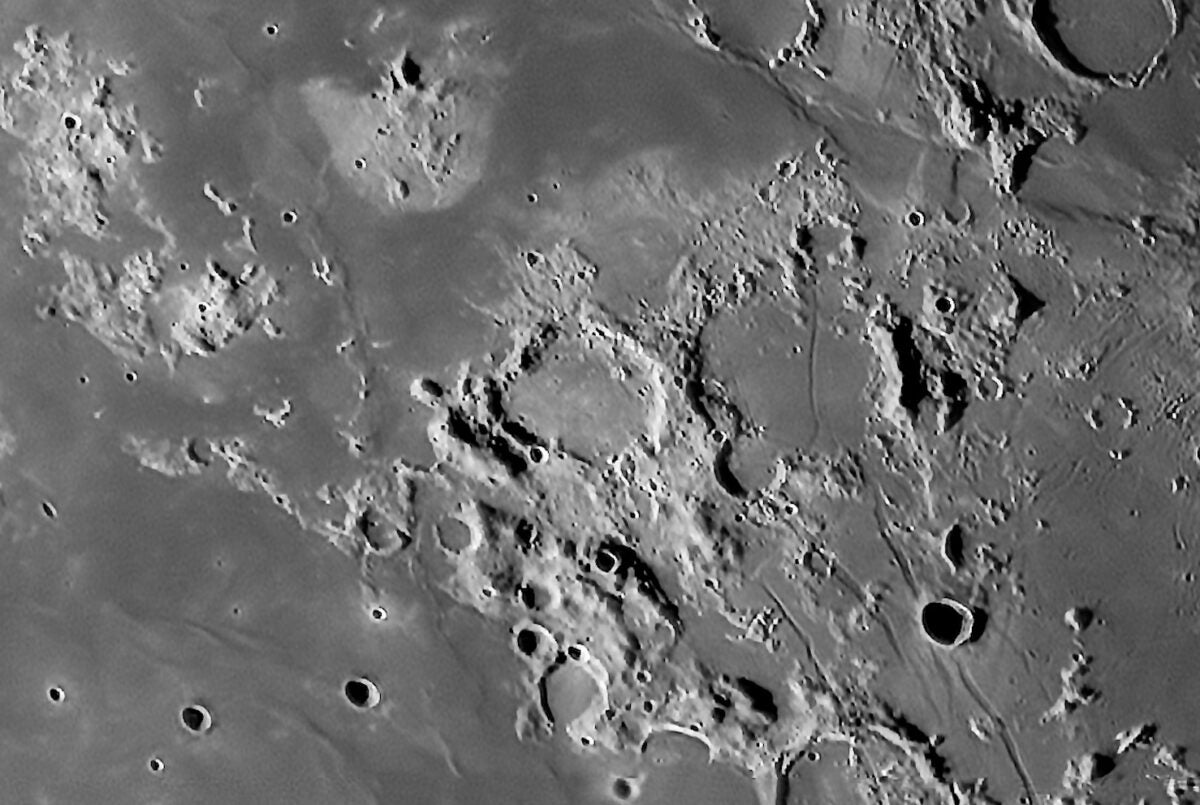
Named by: Unknown
Official name: None
Size: 44 miles (70 km)
Coordinates: 16.8° S, 31.5° W
Feature named after: The appearance of a fireman’s helmet
The Fireman’s Hat, sometimes called the Helmet, is the popular name for the half-Moon-shaped light-colored volcanic mound at upper left in the image. In this north-up view, the Fireman’s Hat is upside down. The 43-by-31-mile (70 by 50 km) feature has no official name, but is also unofficially called the Agatharchides Dome, in reference to its proximity to Agatharchides Crater.
17. Thor’s Hammer
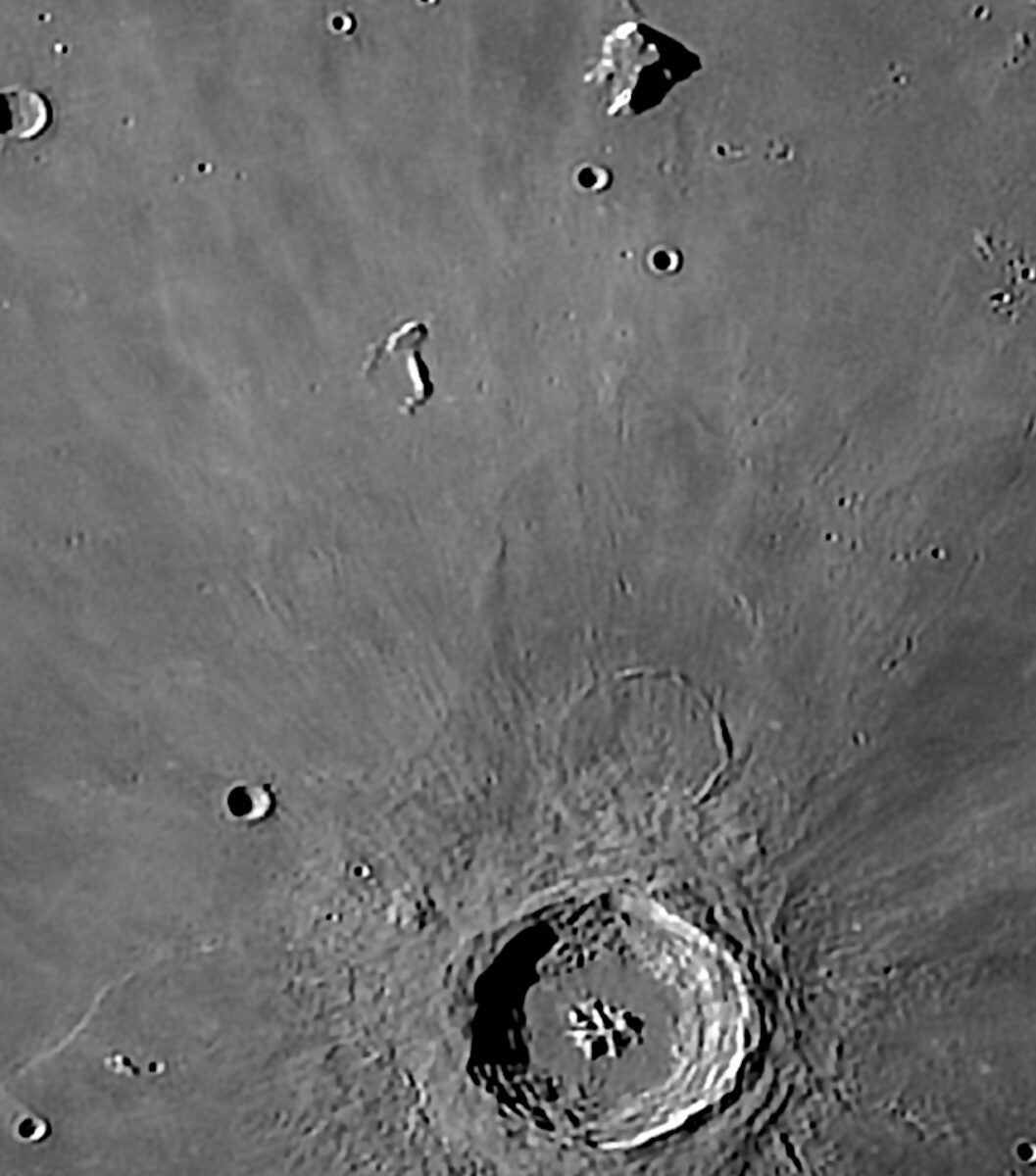
Named by: Robert Reeves
Official name: Piton Gamma
Size: 11 miles (18 km)
Coordinates: 38.2° N, 1.8° W
Feature named after: Similarity to Thor’s warhammer
The T-shaped ridges of Piton Gamma on northern Mare Imbrium mimic the shape of the magical hammer Mjolnir wielded by the mythical Norse god Thor. The 6-mile-wide (9 km) hammer head rises 1,300 feet (400 m) above the surrounding plains, while the 11-mile-long (18 km) handle rises 1,600 feet (500 m).
18. The Cobra Head
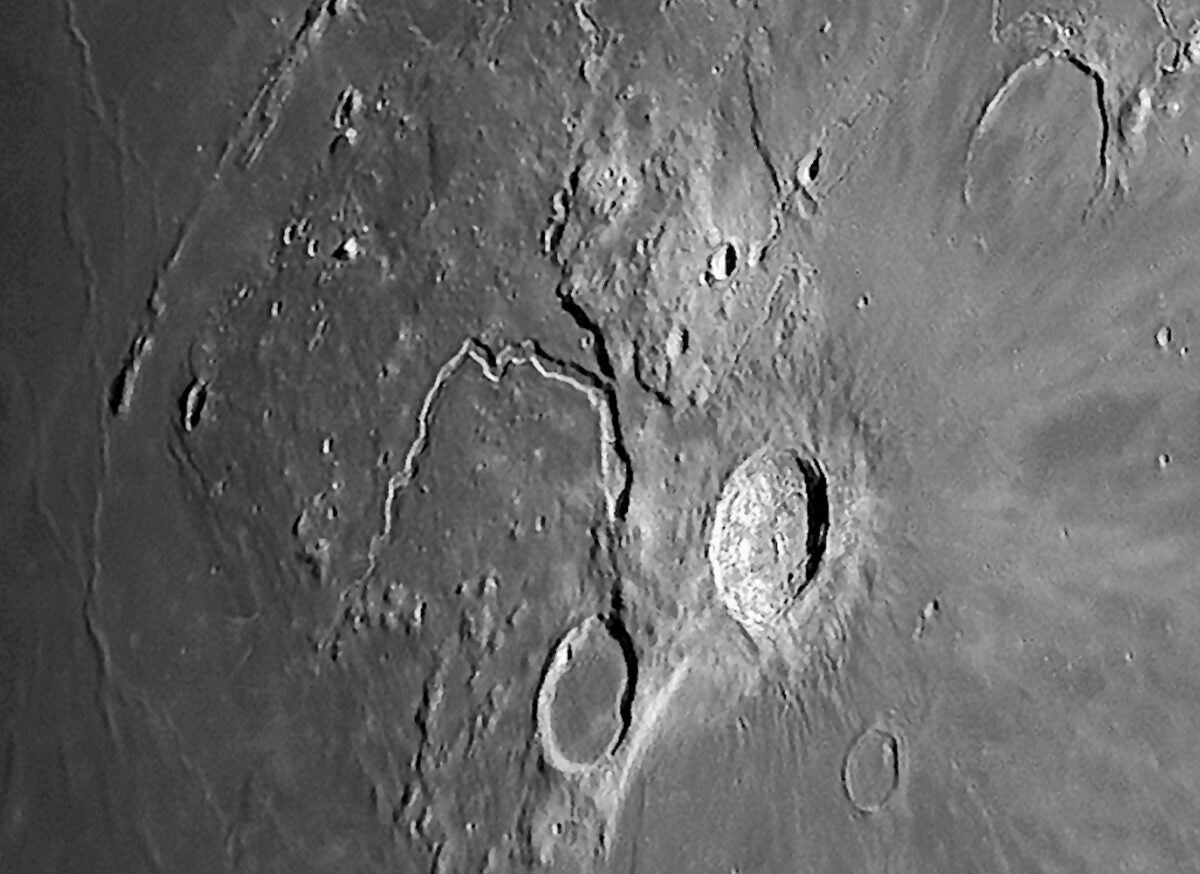
Named by: Unknown
Official name: None
Size: 5 miles (8 km)
Coordinates: 24.5° N, 49.2° W
Feature named after: Appearance of a snake head
The unnamed volcanic pit at the source of the lava flows that channeled through Schröter’s Valley on the Aristarchus Plateau is no wider than the rille forming the valley. While small compared to prominent craters, it is one of the largest volcanic pits on the Moon. The snakelike appearance of Schröter’s Valley inspires the name the Cobra Head.
19. The Ninja Star
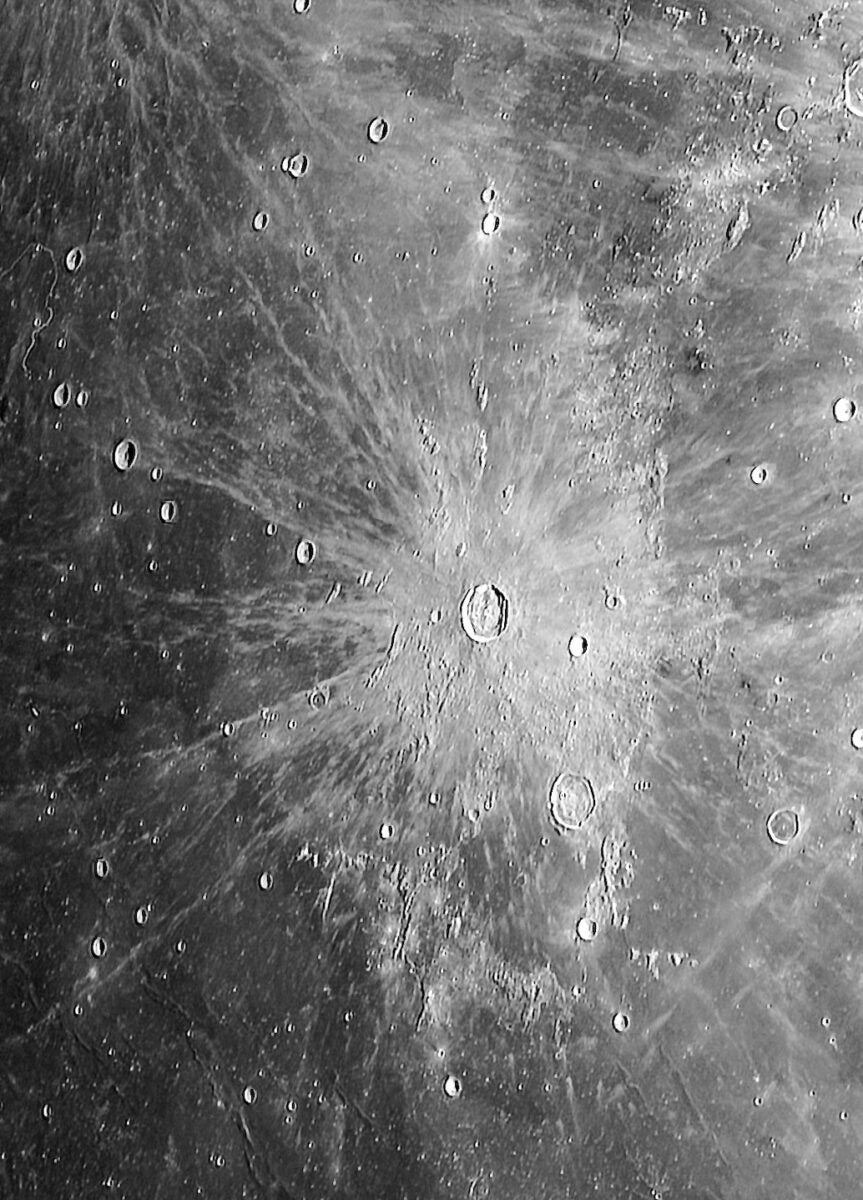
Named by: Unknown
Official name: Kepler rays
Size: 311 miles (500 km)
Coordinates: 8.1° N, 38.1° W
Feature named after: Ray pattern resembling a ninja star
Kepler Crater’s spectacular ray system is noted for its unusually thick western spokes and nearly solid fan of eastern rays. Mountain ridges west of Kepler act like a dam, breaking the westward flow of the rays into individual spokes. This circular splash of rays inspires the nickname the Ninja Star.
20. The Golden Handle
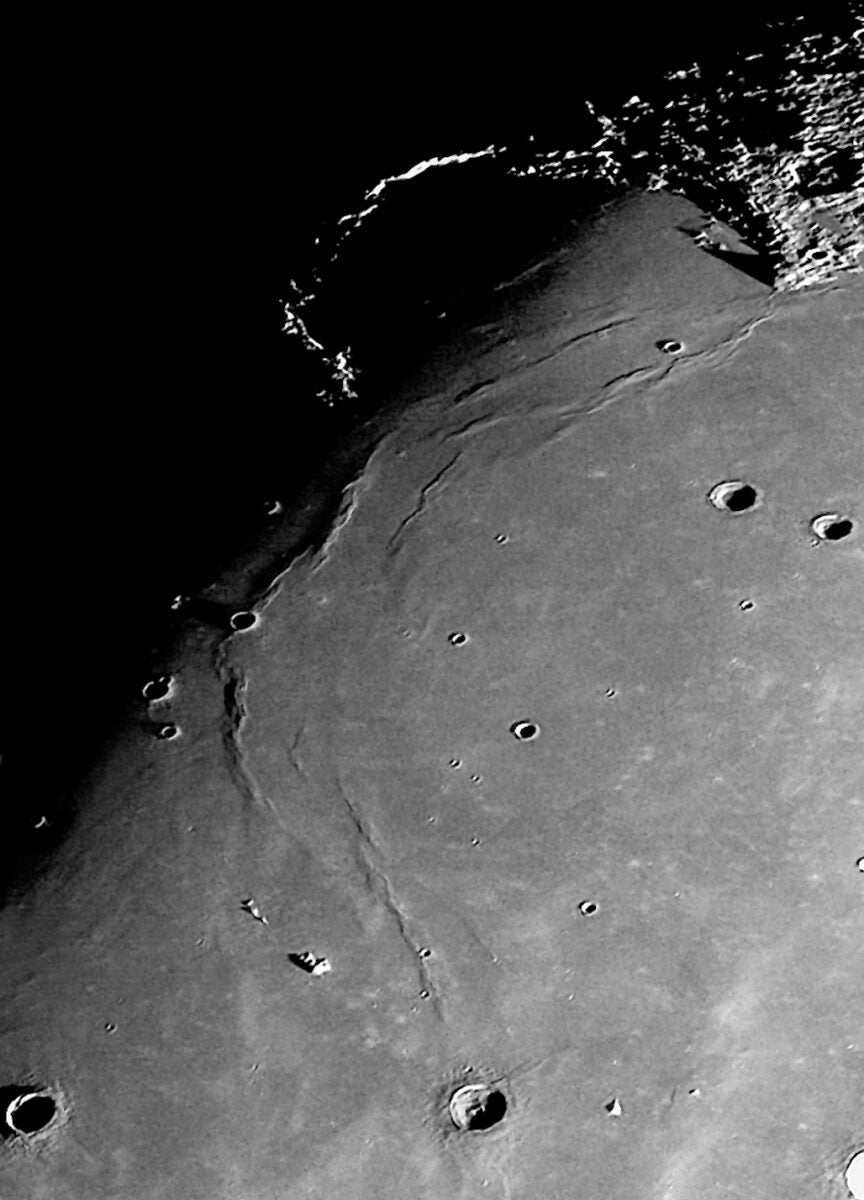
Named by: Unknown
Official name: Jura Mountains
Size: 155 miles (250 km)
Coordinates: 47.5° N, 36.7° W
Feature named after: Appearance of a curved handle at regional sunrise
Sunrise breaking across the crest of the Jura Mountains (Montes Jura) cradling Sinus Iridum on the northwestern edge of Mare Imbrium illuminates the mountain range before the floor of Sinus Iridum becomes visible. The bright mountain rim floating above the darkness creates the illusion of a curved handle against the black background of space.

